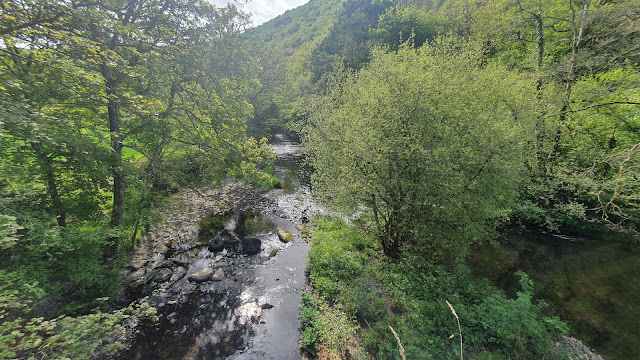A week away outside of school holidays has not happened for us for just under 30 years! We were returning to the cottage we had in August 2020 just outside Okehampton and like then we set off early and had our breakfast looking out across the farmland of Labrador Bay just outside Teignmouth.
Like the previous visit the search was on for one of the country's rarest breeding birds and one that is confined to the coastal farmland along the Devon coast, the Cirl Bunting.
Cirl Buntings were once widespread and common across
much of southern England, but in recent years, they have become rare and only
found in south Devon, mostly confined to coastal farmland between Plymouth and
Exeter.
During the winter, Cirl Buntings forage in weedy stubble
fields, feeding on seeds and spilt grain. In the summer, they nest in
hedges or scrub, and forage in unimproved grassland full of invertebrates -
grasshoppers are a particularly valuable food for chicks. As Cirl Buntings
are very sedentary (they only move up to 2 km between their breeding and
wintering areas), it is vital all these habitats are close to each other.
Changes in agriculture during the 20th century have made
farms more productive, but these changes have meant Cirl Buntings have struggled
to find food and nesting sites. Technological advances such as autumn-sown
cereals replacing spring-sown varieties, more efficient machinery resulting in
less spilt grain, increased fertiliser and pesticide use and hedge removal to
create larger fields have all had an impact.
A widespread trend towards specialised farms has seen farms
in the west of the country converting to mainly grass and farms in the east
growing arable crops. This has resulted in a reduction of mixed farms,
which makes life very difficult for a species like the Cirl Bunting which needs
both grass and arable habitats close to each other.
So what has been the reason for the success on the South Devon coast for this stunning little birds? In Devon, small traditionally-managed coastal farms have persisted, the exposed coastal environment making spring crops a more viable option than winter cropping. This has made this area more appealing to Cirl Buntings.
A mixed farming environment that includes winter stubbles is
the key to helping this colourful bird and the support of the farming community has been vital in Cirl Buntings becoming more secure in the UK.
We walked alongside the top hedge and the field stretches down towards the coast at an alarming angle.
It was good to see rabbits enjoying the early morning sunshine alongside the hedge and fences.
The Cirl Bunting Project has been a great success and is one
of the UK's best farmland species recovery stories.
By 2009, The National Cirl Bunting Survey (RSPB/Natural
England) recorded 862 territories, with some range expansion, and in 2016 a
milestone of over 1,000 pairs was reached – an amazing result that was way
beyond expectations at the start of the project when the aim was to stop them
being lost as a breeding species from the UK.
From Labrador Bay we headed north and then a little west into Dartmoor. Our next stop was to be Dunsford Wood and a walk alongside the River Teign through mixed woodland. On the last visit here the woods were crowded and noisy, today as we walked across the bridge that crossed the river we seemed to have it all to ourselves.
Then they both disappeared and we walked on.
Another river specialist is the Grey Wagtail and these could be heard but were not that easy to see, then this female appeared on a boulder in the middle of the river, the sun picking it out though the trees.
Every so often the path would divert into an open glade full of Bluebells and more Ransomes.
Back on the river we came across another Dipper. This one was a little closer and was preening which gave me the opportunity to get a little closer and to get enough shots to test the best exposure in the dark water conditions. It turns out there were quite a few good ones.
The woods and reserve are known for the huge display of wild daffodils in March. The best place to experience this is the aptly named Daffodil Glade at the far end of the trail from the Two Steps Bridge. Today though the glade was covered in Bluebells.
A Redstart could be heard from the distant trees and in amongst the Bluebells were more Early Purple Orchids.
Moving back into the woodland, a Green-veined White on a clump of bramble..
The Bluebells were also present under the Hazel and Beech trees in the woodland.







































































No comments:
Post a Comment